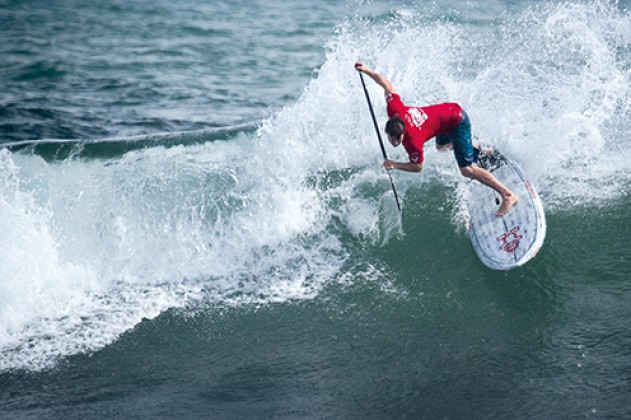STEP UP TO HIGH PERFORMANCE SHORT BOARDS
With Sean Poynter
There are many ways to express yourself on a stand-up, and for many, this still involves sticking vertical pokes off the lip, smacking roundhouse cutbacks off the whitewater and busting the fins out now and again. Just a few years ago an 8ft SUP was unthinkable, but if you’ve got it in your mind to shred, then the time to step down to a smaller board may be sooner than you anticipate.
Riding smaller boards speaks to me as I come from a shortboarding surfing background. I was a pro-junior in shortboarding, I was always riding shortboards and that’s what I wanted to infuse with my stand-up. I think I’m well on the way to narrowing the gap between my stand-up and my shortboarding. We’ve got a way to go, but we’re getting there.
In waves, the shorter stand-up board is more manoeuvrable and easier to control. You’ll feel more comfortable with the board since you’re not tied down to some massive lug of a board you don’t have much influence over. I would almost recommend it’s the way to go once you get comfortable with your stand-up; you really don’t want be tanking a massive 10-12ft board around in the line up, for as much you think you’re in control of it, you’re not.
Where to go
A high performance board thrives in nearly all conditions, but obviously it’s better to be in smoother conditions when the wind isn’t blowing so strongly.
There’s no need to push the boundaries if you don’t feel you are up to the challenge, say if the waves are too big or it’s too crowded. Be smart and don’t cluster a crowded line-up with your stand-up as it’s hazardous and doesn’t make the sport look good. Just take your time and choose a different break. With a smaller board you’re not going to be riding massive waves, most people are naturally riding small waves with their SUPs anyway. That said, in smaller surf you want a smaller board to fit in the pocket if you’re going to be doing cutbacks and manoeuvres and so forth. Your chances of making a cutback and a smooth transition are considerably greater on an 8ft board over a 10 footer.
If the wave is punchy and a little throatier, a shorter board is a better way for you to go. You can set the edge a little bit quicker and avoid that nose dive.
Versus a longer board when paddling
You will lose paddling speed on a smaller board, just in the sheer volume of the board. A shorter board will suffer more from row effect, so to increase the amount of strokes you can Make on one side of the board, I use the ‘out to in’ stroke.
Plant that paddle ahead of you up by the nose and further out, and when you stroke in; bring the paddle closer to your board. This helps you to stay level and you can just about turn to the same side you are paddling.
Versus a longer board in the surf
In the surf, you can pivot your smaller board around when you see a wave on top of you by putting your foot on the tail and kicking the board around almost immediately. In that degree, the acceleration to get onto a wave increases over a longer board. If you choose to hang out at the back, you’ll probably get in to the waves a little bit later but what smaller boards do is force you to up the ante on your output, and that’s what’s fun about it, it’s not just a pleasure cruise, you’re going to work harder; if you put a lot more energy into it you can compare with anyone out there. But to be realistic you’re not gonna be able to casually cruise up and into a wave out back.
The road to downsizing
I started paddling in July 2009; I first picked up a standup paddle board when I was living in Florida where the waves are really small, I think that was a 9’8 and then I moved down to a 9ft board. That September I moved to California and met with Starboard at Battle of the Paddle, and then they had the first board of its kind, a 7’11 that was unheard of then. After the comp, I hopped on it and got to surfing at Dana Point and I never looked back.
From that 7’11 I started working on a 6’6 with Brian Szymanski and we decided ‘that’s small enough’. Today my go-to board is the 7’7 x 27”, that’s what I’m going to be riding in (the La Torche Pro) France. My other is a step up board from that, an 8’ x 28”. Both boards are brushed carbon; it has a liveliness to it that you don’t get from any other board.
Want to know more? Follow Sean at www.seanpoynter.com
INSIDER TRADING…
1. Remember the out-to-in stroke to reduce row effect. Don’t hut the rail with your paddle strokes!
2. Settle into your new board in flat water.
3. Practise tight pivot turns on both sides for better response for when the waves are on top of you.
4. Don’t cluster a crowded line-up, be patient and find another spot.
5. The progression to a shorter board may be quicker than you think.

